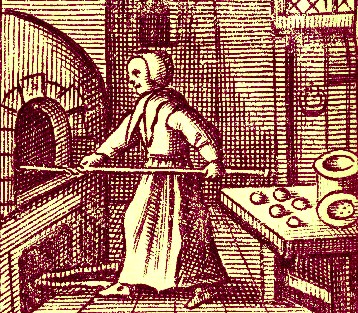
Royal Navy Provisioning Locations Menu: 1 2 3 4 Next>>
Golden Age of Piracy Provisioning Locations - Royal Navy Page 1
English Royal Navy Victualling
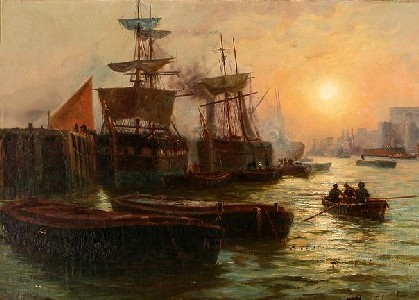
Artist: John De Lacy - Harbour Scene from London (19th c.)
Before the creation of a navy Victualling Department in 1550, naval victualling was performed individuals who were given commissions to provide food and drink to navy ships. The food was purchased by local merchants at ports where supplies were to be picked up by people sent from London.1 During this period, "Victualling stores and requisites were obtained by purveyance [the right of a sovereign to buy things at a fixed, lower price], and there was not consequently much eagerness displayed to sell to the crown."2 The goods were transported by hired ship tenders who brought the victuals to the larger naval vessels. Even the navy was hired. Historian Michael Oppenheim gave an example of England's naval force in 1514, explaining that at that time "there were twenty-one hired fighting ships and fifteen victuallers engaged."3 The permanent Royal navy was still in the formative stages in 1550, "making the 16th century a crucial period of experimentation and development... By 1559 it was considered necessary to construct a centralised base for the provision of these supplies to the fleet, which decision led to the establishment of what was in effect the countries' first mass catering factory at Tower Hill [in London]."4
The early victualling system had a variety of problems. From the government's side, there was the problem of late payments to victuallers and the inability to predict how much food would be required in each given year. From the navy side, they were associated with the way the pursers (those in charge of each ship's account) were paid which encouraged cheating on both reporting and maintaining supplies.

Artist: John Hayls - Samuel Pepys (1666)
As Clerk of Acts to the Royal Navy, Samuel Pepys famously observed in 1665, "Among other things it pleased me to have it demonstrated, that a Purser without professed cheating is a professed loser, twice as much as he gets."5 Pepys tried to fix the system so that the pursers were encouraged to economize but discouraged from cheating. Historian N. A. M. Rodger calls Pepys' reforms his "most important and lasting contribution to the victualling system"6. However, they did not solve the problems.
In an effort to improve victualling, the Admiralty created the Victualling Board in 1683 to have more direct control over the process and improve the efficiency of the process and quality of the food.7 As part of this effort, the Board purchased their own vessels to ferry the victuals from land to the ships at anchor waiting to be re-provisioned.8
Through its centralised purchasing and manufacture, the Victualling Board became the country's first mass caterer... [which] was on the whole discharged with considerable credit. Aware that the health, happiness and morale of crews depended in large part on their diet, the Admiralty early on insisted that the best-quality provisions should be supplied, and the Victualling Board constantly strove to improve the manufacturing processes and experiment with new foods and methods of preservation.9

A Sampling of Navy Designated Victualling Stations Between 1665-1748,
Image Artist: Francis Holman - Blackwall Yard from the Thames (1784)
The provisioning requirements were extensive because Royal Navy vessels sailed the waters of the Mediterranean, East and West Indies and Europe. When England was at war, the navy was necessarily staffed up, creating greater need for an effective victualling system. During the golden age of piracy, England was involved in two large scale wars with naval components: the War of the League of Augsberg against France and the Jacobites (1688-1697) and the War of Spanish Succession against France, Spain and Bavaria (1701-1714). Before the golden age of piracy, England was at war with the Dutch and Spanish (among others) three different times: 1652-1654, 1665-1667 and 1672-1674. These are usually called the Anglo-Dutch Wars. Shortly after the Golden Age of Piracy they were again at war with Spain during the War of Jenkin's Ear (1739-1748). Being a crucial component of navy warfare, victualling stations were expanded and improved and new victualling outposts were created at these times. The chart at left shows where victualling stations and outposts were located between 1665 and 1748.
Perhaps the most notable thing about this chart is the consistency with which the English yards at London, Portsmouth, Dover and Plymouth were used during this period. The first four locations all had established dockyards with some form of victualling station as we shall see.
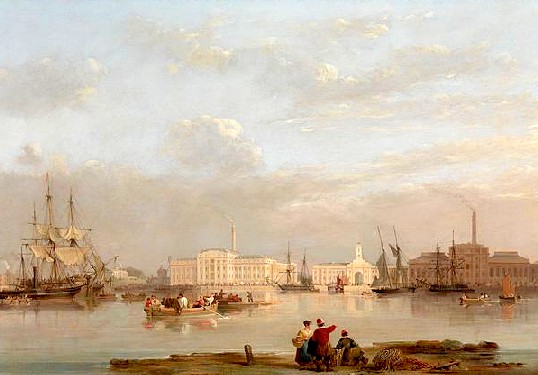
Artist: Nicholas Condy - Victualling Office at Plymouth (1835)
Curiously, Chatham does not show up for this period, although it was certainly in use. It is likely that the sources which don't mention Chatham have included it with London; the victualling station at Chatham is about 30 miles away from London and, like London, was used to victual ships anchored at the Nore in the Thames estuary. In fact, as historian Jonathan Coad explains,
Chatham, Portsmouth and Plymouth were all sited next to substantial and relatively safe anchorages, an advantage denied to the other home yards. This effectively ensured that for more than 250 years from the start of the 18th century, these three home dockyards consistently received the major share of government funding. Alongside them grew the buildings of the victualling and ordnance yards.10
1 Michael Oppenheim, A History of the Administration of the Royal Navy, Vol 1, 1896, p. 81; 2 Oppenheim, p. 82; 3 Oppenheim, p. 87-8; 4 Ian Granger and Christopher Philpotts, The Royal Navy victualling yard, East Smithfield, London, 2010, p. 2; 5 Samuel Pepys, Pepys Diary, November 22, 1665; 6 N. A,. M. Rodger, The Command of the Ocean, A Naval History of Britain, 2006, p. 106; 7 Karen McBride, Tony Hines and Russell Craig, A rum deal - the purser’s measure and accounting control of materials in the Royal Navy, 1665-1832, 2016, p. 3; 8 McBride, Hines and Craig, p. 8-9; 9 J. D. Davies, Pepys's Navy, 2008, p. 200; 10 Jonathan Coad, Support for the Fleet, 2013, p. 4
England's Naval Victualling Stations During the Golden Age of Piracy
This section looks at the history of the main victualling ports located in England which were in use by the navy during the golden age of piracy including London, Portsmouth, Dover, Plymouth Chatham/Sheerness and Harwich. In some cases, the precise history of naval victualling locations is not well documented in the sources available to the author, particularly in the early years of naval service in England when they were frequently contracted or were included as part of a larger naval dockyard. The one exception is victualling yard at Tower Hill in London where an archeological survey was performed.
Victualling at London (Tower Hill)
London was the location which supplied the majority of the victuals to other sites. As historian John Ehrman 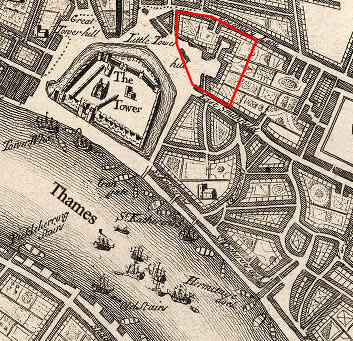
Cartographer: John Senex
Approximate Location of the Tower Hill Victualling Yard, London (1721)
explains, it made sense because "to a large extent [coordination of procurement of victuals] already existed in the London market. …The markets of the capital could meet a large proportion of the navy's demands more regularly and more simply than the regions of supply themselves."1 Roger Morriss adds, "Until the mid eighteenth century London was the central market of agricultural produce in Britain and the navy was able to tap that supply."2 Paula Watson says that the Victualling Board, which was created in 1683, relied "heavily on the
Tower Hill yard, which with all its faults, was the most complete
in existence."3
Tower Hill in London was purchased by the navy from Sir Arthur Darcy in the 1560s for £1200.4 The hill was the site of the Cistercian Abbey of St. Mary Graces, a structure Darcy had removed after taking possession of it in 1541. The navy built an office on the east side of Tower Hill which became the victualling offices.
These offices served as the Victualling Board's center of operations until the mid 1740s when they relocated to a larger building at Deptford.5 With all the food processing taking place on the site, it must have been a noisome place to work. In June of 1649, the Navy Commissioners decided to use rooms in the office, "but in 1653 they found the annoyance caused by the proximity of the victuallers' slaughterhouses there to be unbearable."6
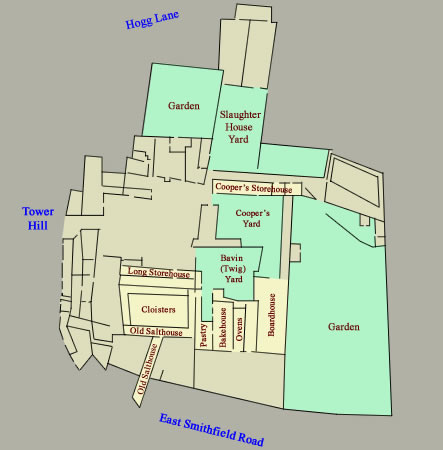
Plan of the Tower Hill Victualling Yard from 1635, Based on the Copy Found in
'The Royal Navy Victualling Yard, East Smithfield, London', 2010, p. 10
The development of the yard changed repeatedly over the centuries from its establishment to the golden age of piracy. "The yard initially contained a bakery, a cooperage [for building barrels] various storehouses and a number of dwellings for the officers of the yard"7. Around 1550, the navy "builded a large Storehouse for victuale, and convenient Ovens are builded there, for baking of Bisket to serve her Majesties Shippes."8 This building was 80 x 20 feet, with a granary above it. It reportedly held four ovens in 1635.9 In the 1560s, supplementary storehouses were rented along the Thames. A long storehouse was built for the coopers in 1565 which was used to store old casks and timber for new ones and a slaughterhouse was purchased in the 1590s.10
A survey in 1635 resulted in the plan of the location, a copy of which can be seen at right. This plan shows the structures added up to that point as well as two gardens and salt houses. No facilities were constructed for making cheese or brewing beer, so they had to be brought in from outside vendors.11 The 'bavin yard' was used to store kindling wood used in the ovens as well as for fires lit in any of the other buildings on the site.12 The salt houses were probably in use before 1600 to pack and preserve freshly slaughtered meat.13 The two gardens were identified as belonging to Ralph Burrows (upper left) and Richard Waterman (lower right). This suggests they were for the private use of these men rather than used to grow food to be supplied to ships, although this is not entirely clear from the evidence.
The yard continued to be expanded and modified throughout the 17th and 18th centuries. Morriss explains,
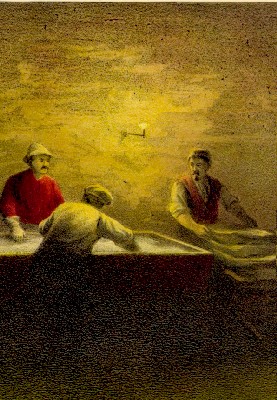
Salting and Stacking Pork in Cincinnati (1873)
At the beginning of the eighteenth century, the main victualling yard was on Tower Hill in London. The yard had a slaughterhouse, which could deal with up to 200 oxen or hogs at a time, a cutting house, hanging sheds and pickle yard; a baking house for bread, known as biscuit; and a cooperage [for making barrels]. The Hartshorn brewery in east Smithfield, near the Tower, was purchased in 1701 to supplement a rented brewery at St Catherine's wharf. But mills for grinding grain were at Rotherhithe and storage was short: during the 1701-13 war, five ships were moored in the Thames to serve as extra storage.14
More storehouses were built there in 1704 for biscuit, beer, and flesh.15 These three items all required special processing, so "the work at the London yard was divided between the cuttinghouse, the Hartshorn Brewhouse, the bakehouse and the cooperage."16
Since it was the hub of naval victualling to most of the other ports, Tower Hill had a variety of officers stationed there during the golden age of piracy. The Victualling Board created the office of Clerk of the Cheque in 1704, apppointing Thomas James to the office who was to work "with the storekeepers in viewing the quality and taking account of the quantity of all sorts of provisions received into store."17
A variety of other officers were stationed there as well. The newly created victualling board appointed a variety of men to staff the victualling location who were involved in preparing victuals and transportint them. They include Andrew Crawley, Clerk of the Cutting House, John Gosling, Master Butcher; Josiah/Joseph Keeting, Clerk of the Bakehouse; Richard Babington, Clerk of the Brewhouse; Jeremiah King, Master Cooper and Richard Boult, Hoytaker and Buyer of Corn.18 Decades later the positions had altered only a little, although those in charge of them were different. The Board reported in July, 1710 that Samuel Rowe as Clerk of the Cuttinghouse (since January, 1708), John Clifton as Clerk of Bakehouse who also served as storekeeper for peas and oatmeal (since December, 1708), Bernard Goddard as Clerk of the Brewhouse (since January, 1708), Thomas Perry as Master Barrel Cooper (since November, 1706), Henry Pyke as Hoytaker in charge of the transport boats and Charles Mason as transport paymaster and receiver.19 The Clerk of Issues was responsible for orders to the London yard issuing the food to outports which were supplied by London.20
In 1704, instructions were issued to the two officers in charge of the meat cutting house at Tower Hill: the Master Butcher and the Clerk of the Cuttinghouse. The Master Butcher made sure incoming cattle met the standards established by the Navy Board, oversaw slaughtering of the cattle and curing the meat after it was cut. His instructions directed him
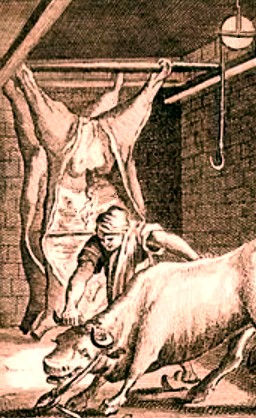
Butcher Slaughtering and Preparing Cattle,
From Denis Diderot's Encyclopedie (1763)
to see to the clean and well dressing the oxen and hogs, that the butchers and others employed therein perform their duty in all respects as they ought to do, and when you observe any of them to be. negligent or remiss therein, to acquaint us [the board] therewith in order to their being discharged, and likewise to take care that the slaughter-house, hanging house and everything thereunto belonging, be always clean and in good order.21
He and the Clerk of the Cuttinghouse decided when the weather was appropriate for slaughtering and preparing salted meats. Meat was slaughtered in the fall and winter, "partly because meat killed and packed in cool weather keeps better than that prepared when it is warm and partly because the difficulty of feeding cattle through the winter months meant that farmers did not want to keep them."22
The Clerk was also in charge of storing meat once it was packed. He was
to take particular care that you receive no provisions or stores but what are very good, in all respects fit for the service of her Majesty's navy and answerable to the contract by which they are received, and to certify the same on the back of the bill made out for our signing and you are also to take especial care from time to time to keep the contractors to their agreements as well in respect to the quantity, as in the quality and timely delivery thereof, and not to receive any more of any species than you are warranted by the contract nor take any into store after the time for delivery is expired without having a minute from the board for your justification.23
At the bakehouse, bread was fashioned into five thin cakes per pound and, after baking, were put into a dry warm loft before being placed in bags that were sewn on the premises for that purpose. The role of the Clerk of the Bakehouse was in part
to prevent the extravagant waste of wood, the hurrying of the work, which not having its due time in a moderate oven is blistered, scorched, and not well dried and thereby not so durable for a voyage.24
Baking Bread, From The Queen-Like Closet Or Rich Cabinet, Frontispiece,
By Hannah Woolley (1670)
The clerk was also responsible for receiving, packaging, storing and issuing additional biscuit, oatmeal and peas. The additional biscuit was required because the bakehouse couldn't produce enough bread to meet the needs of the navy during the war. To assure that quality of the bread and its storage, the Clerk of the Bakehouse or his assistant was to be present when the biscuit bags were filled or being delivered directly shipboard.25
The Tower Hill location was expensive to run and had limited access to the waterfront because it was not next to the Thames.26 Determined to be insufficient for the needs of the Dutch Wars in the latter half of the 17th century, "both for the processing and the distribution of provisions. ...it was ...overgrown with tenements and small workshops which reduced its facilities for keeping cattle, thus leading to their premature slaughter when fresh supplies were brought in, and interfered unduly with the processing and storage of food."27 In addition, it required tenders to take the food out to the navy vessels. At its peak, fifty tenders were added to serve Tower Hill to transport navy food to the ships and other victualling bases. This was a large added expense as the boats were hired by the month.28 In 1742, various tasks performed at this yard were moved to the Deptford. The Chatham yard was finally closed in 1785.29
1 John Ehrman, The Navy in the War of William III 1689-1697: Its State and Direction, 1957, p. 148-9; 2 Roger Morriss, The Foundations of British Maritime Ascendancy: Resources, Logistics and the State, 1755–1815, 2010, p. 272; 3 Paula K. Watson, "The Commission for Victualling the Navy, the Commission for Sick and Wounded Seamen and the Prisoners of War and the Commission for Transport, 1702–1714," University of London PhD thesis, 1965, p. 115; 4 Michael Oppenheim, A History of the Administration of the Royal Navy, Vol 1, 1896, p. 140 & J. D. Davies, Pepys's Navy, 2008, p. 200; 5 Davies, p. 200; 6 Oppenheim, p. 349; 7 Ian Granger and Christopher Philpotts, The Royal Navy victualling yard, East Smithfield, London, 2010, p. 2; 8 John Stow, A Survey of London, Vol 1, 1908, p. 125; 9 Granger and Philpotts, p. 34; 10 Granger and Philpotts, p. 9; 11 Granger and Philpotts, p. 11; 12 Granger and Philpotts, p. 16; 13 Granger and Philpotts, p. 21; 14 Roger Morriss, The Foundations of British Maritime Ascendancy: Resources, Logistics and the State, 1755–1815, 2010, p. 284; 15 Commander R. D. Merriman, Queen Anne's Navy, 1961, p. 249; 16 Watson, p. 77; 17 'Adm 111/2p 18 Sept. 1704', cited in Watson, p. 152; 18 His Majesty's Stationery Office, Calendar of Treasury Books, Volume 7, 1681-1685, 1916, p. 968 & 1370; 19 "46. Victualling Board to Secretary of the Admiralty, 4th July 1710," Queen Anne's Navy, Commander R. D. Merriman, ed.,1961, p. 295, Watson, p. 76 & Calendar of Treasury Books, Volume 24, 1710, Sept. 21; 20 Watson, p. 76; 21 'Instructions to master butchert clause 5, Adm. 110/5, p. 376', Cited in Watson, p. 79; 21 Janet MacDonald, Feeding Nelsons Navy, 2014, p. 20; 23 'Instructions to clerk of cuttinghouse, clause 5, Adm 7/215', cited in Watson, p. 79-80; 24 'Adm 7/215,Instructions for the well management of the bakehouse', cited in Watson, p. 83; 25 Watson, p. 83-4; 26 Davies, p. 200; 27,28 Ehrman, p. 154; 29 Granger and Philpotts, p. 2

